WHAT'S NEW:
Eruption Confirmed!
New lava (rumbleometer stuck in flow) SE rift zone
(posted 9/1/98)
BACKGROUND:
Technology (ROV, ships, etc.)
Other 1998 Axial cruise reports
EXPEDITION:
Science Objectives
Calendar
Today's Science News
Participant Perspective
Teacher Logbook
EDUCATION:
Curriculum
Teacher Observations
Questions/Answers from sea
MULTIMEDIA:
(video clips, animations, sounds)
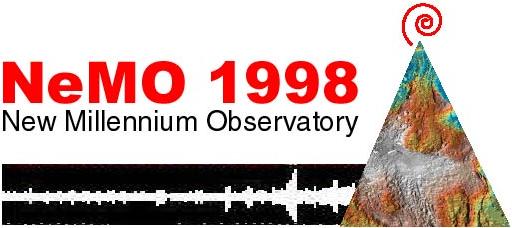
Logbook
September 13, 1998
September 13, 1998
Contents:
Science Report
Daily Science Report - Sep 13
ship's location = 45 56.9N/129 59.0W
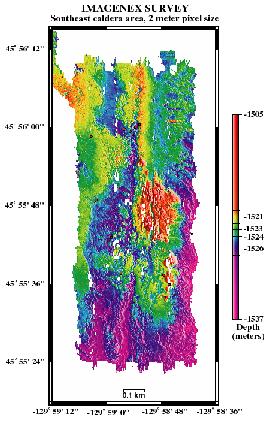
The last 3 ROPOS dives (474, 475, 476) were devoted to mapping the
northern extent of the 1998 lava flow on Axial's upper south rift zone.
It was originally intended to be just one dive but ROPOS had
to come up early twice due to vehicle problems before the mapping was
completed. In addition to the geologic traverses on the bottom and
collecting
The extensometer instruments that we recovered several dives ago,
show a 4 cm distance decrease across the measured baseline at the same
time that the earthquake swarm occurred in January 1998. This is also the
same time that the rumbleometer (the one that was recovered from the
center of the caldera) saw a subsidence of 3.2 meters! This distance
change seen by the extensometers is interpreted as due to a deflation
of the entire volcano summit as magma moved into the south rift zone.
Listing of all Science News postings
Last month, I had the opportunity to visit Rabaul in Papua New Guinea. In 1994,
the city was destroyed as two volcanoes erupted. The seismologists were able to
warn the inhabitants who were able to evacuate in time; most people have now
moved away. As I look at the new lavas on Axial Volcano, I remember the huge
fields of tubeworms we saw here last year. Then, we sat our sub in the middle
of the field and the tubeworms (called vestimentiferans) towered above us -
nearly 2 meters tall! Hundreds of thousands of worm lives were lost here. They
had no warning....and even if they did, they are attached to the rocks, and
cannot move. Why would anything choose to live in such a precarious place??
(photo below left shows "baby" tubeworms on the edge of the new lava flow)
It's the food source that brings them. You have heard from our microbiologists
describing the abundant microbes here. Chemical reactions in the vent fluid
feeds their growth and the big animals eat the bacteria. It is a very hard
place to live for many reasons: the heavy metals, the sulphide poisons, the
isolation and, not the least, eruptions and extinction. Since I have worked on
Juan de Fuca Ridge - 16 years now - nearly every animal we have found is a
species biologists have not seen before. There are over 400 new species at
vents around the world. On this ridge, we have found about 75 new species from
big worms to tiny copepods. And we have a couple more from this cruise!!
An example is the tubeworm that we first found here on Axial in 1983. The
expert in the Smithsonian named it Ridgeia piscesae - "the ridge worm of
Pisces". Pisces was the name of the Canadian submersible we were using. The
vent tubeworms belong to a group of animals you won't find often anywhere else.
They shocked biologists when first discovered....they have no mouth, no gut no
anus. Just a giant sausage in a tube with a red tuft sticking out the top.
Well that sausage turns out to be a highly evolved adaptation to vents: it is
filled with red blood and bacteria. Why bother slurping up bacteria for food
when you can just grow them inside you? The worms pick up oxygen, dissolved
sulphide, and carbon dioxide with their gills. These compounds travel in the
blood to the bacteria who use energy from the oxidation of sulphide to fix the
carbon dioxide into scrumptious sugars. The sugars pass to the worm ... how
efficient!
But what about all those dead worms buried under the lavas? Not all are gone:
we found some sticking out the edges. When we picked up some to examine (see photo right of samples being removed from ROPOS), we
found they are full of eggs and sperm - in the face of disaster, life goes on!!!
One of the projects I am doing out here is to find out how quickly the new
vents are colonized. And eight months later, it has already happened.
Different vents have different animals, which surprises me (different chemistry
maybe??). But we did find new tubeworms recruiting to the lavas. The males
fertilize the females who release tiny embryos into the water. These turn into
larvae that are carried by the currents for many days. Those babies are now
landing on the lavas. We plan to try to bring a few live tubeworms back to
Victoria where we will keep them in special conditions and see if we can make
babies there to watch how they grow.
So we have some very special animals who have evolved to live on the edge: the
constant threat of death but the continual chance for rebirth.
It is a great challenge to try to do this type of work out here. But so
rewarding. I am a Professor in
Earth/Ocean Sciences and in
Biology at
University of Victoria. Over the years, my program has evolved to work with
interdisciplinary groups such as this one. But not only is there great pleasure
in working with other scientists, the technologists and pilots of the
ROPOS
group have also taught me and my students a great deal - we delight in their
successes. And a final note: a big hug for my little girl, Arielle, who
started back to school last week; it's hard not to be there.
Listing of all Perspectives postings
September 13 - 1500 hours
It's Sunday afternoon and we have good news and bad news. After a few problems
yesterday with water alarms, ROPOS is back on the bottom taking bacterial mat
samples and surveying two more tracks along the ocean floor. Despite a one hour
delay caused by a video malfunction in the deep recesses of the hydro-lab, this
part of the dive concluded at about 1400 hours and we have begun a long run of
The bad news is that the weather report calls for some relatively nasty stuff
tomorrow and maybe beyond. We are beginning to feel the change in the ship's
motion already this afternoon. The meteorologists are predicting the 35 knots
winds that will guarantee that we'll all be "sleeping" on the cheap roller
coaster for a night or two. Still, we can't complain. There has been very
little of this kind of disturbance in our first 21 days at sea and we are still
averaging somewhere in the vicinity of 15 hours per day of dive time. That's
phenomenal.
We are still looking for questions from shore. We want to keep our scientists
in touch with what folks on shore are thinking about the work being done out
here. If you have any questions you would like to have answered, send them
through the question icon at the end of this page. One common question that has
shown up in a number of different forms is "Where are all the big animals?"
Our
biology professor from the University of Victoria addresses that question in her
science report for today. We are sending along some pictures of the big animals
that we have observed, but the truth is that the area we have been exploring is
only about one-tenth of a mile in length, and in an area of the ocean where big
animals are generally very rare due mainly to a lack of food, we just don't see
many.
We have begun a cribbage tournament among the card-playing members of the crew.
I have my first match this evening. I expect to win the whole thing, but of
course so does everyone else who is competing. The whole crew is beginning to
see the light at the end of the tunnel, and while we still have five days of
science and one day of cleaning and packing ahead of us, we are all looking
forward to a little R and R in Victoria, B.C. One week after I get home I have
to go to Washington D.C. to begin working on the second annual
National Ocean
Science Bowl. I can virtually guarantee that some of the information you find
on this website will find its way into that contest. Those of you who are
teachers at the high school level might want to start thinking about putting
together a team. Last year's contest was superb. I will post information about
the contest to this website as soon as I have reliable dates and places in hand.
If it turns out to be stormy tomorrow so that ROPOS is not able to go in the
water, I'll try to do some catch-up on things we've missed reporting along the
way, or perhaps take you on a quick tour around the ship, provided it will hold
still long enough to have its picture taken. L
Logbook of all Teacher At Sea postings
Question: What is the "bag creature"?
Answer:
A figment of overactive imaginations to some extent. The big jelly
blobs we see around the vents are not creatures at all. [When they were first
found, geologists decided that, since they weren't rock, they had to be
animal and the name stuck.] If you look at them in the lab, they are like round
lumps of Jello: transparent, often with white fuzzy growth on top.
Under the
microscope, there is no structure at all. Our microbiologists will be examining
them because we believe they are sugar wastes produced by bacteria.
So much is
coming out that they stick together and form large blobs.
All Questions/Answers from sea
Life at Sea: Participant Perspective
Verena Tunnicliffe
Professor,
University of Victoria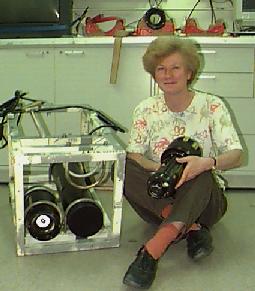 ERUPTION ALERT!! Hi, I'm a marine biologist - my name is
Verena Tunnicliffe.
ERUPTION ALERT!! Hi, I'm a marine biologist - my name is
Verena Tunnicliffe.
(Photo show Dr. Tunnicliffe with her time-lapse camera. When deployed on the seafloor, the camera will take one photo/day of the same region to monitor change.)
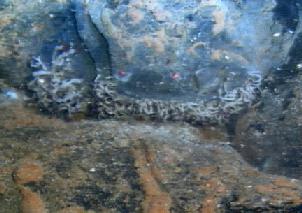
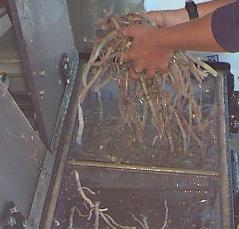
Teacher At Sea Logbook
Question/Answer of the Day
Andra Bobbitt, Seal Rock Oregon
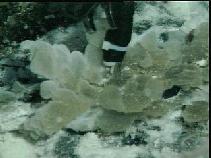
Send Your Question to NeMO
(oar.pmel.vents.webmaster@noaa.gov)
Back to Calendar